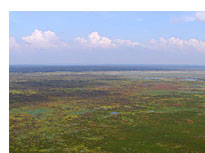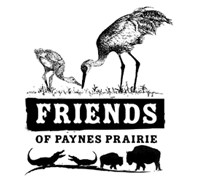

 |
 |
|
Natural Features | Cultural Heritage | Preserve Management | Recreation Early Inhabitants
Paynes Prairie played a significant role in the early settlement of Florida. It was often a stage for bloody conflicts between the Native Americans and those that tried to make Florida home. Spanish FloridaRancho de La Chua, on the Prairie's north rim, is believed to be the site of Hacienda de La Chua, the largest cattle ranch in Spanish Florida. Established before 1637, La Chua was managed by the politically powerful Menendez Marquez family, reached its zenith of prosperity between 1672 and 1695, and operated until the early eighteenth century. Cattle and horses can been seen on the Prairie still today. The wild horses are descendants of those brought over by the Spanish in the early 1500s and left to roam free after the British raids in the early 1600s. "Puc Puggy" - the Flower HunterIn 1774, writer, illustrator, and naturalist, William Bartram was intrigued by the abundance of previously unrecorded animal and plant life on Paynes Prairie which led him to publish Travels. When he first came within sight of the Alachua Savanna, Bartram was awestruck by what he called "the most sudden transition from darkness to light, that can possibly be exhibited in a natural landscape." Also, through his narrative in Travels we have the only detailed description ever written of the first Seminole village, Cuscowilla. Below is one of Bartram's illustrations of the "Great Alachua Savannah" and the village of Cuscowilla.  Steamboats on the PrairieHeavy rains began to flood the basin in 1871 and by 1873 the marsh was large enough to be called Alachua Lake where steampowered boats transported lumber, goods and passengers. In 1891 Alachua Sink, the main drain for the basin, became unclogged and by 1892 the character of the marsh had returned. By 1903 cattleman William Camp began cattle operations on the lush, green prairie grasses.  Natural Features | Cultural Heritage | Preserve Management | Recreation |
 Long before humans made there way to Paynes Prairie, massive prehistoric animals were calling the basin home. The giant ground-sloths, mastodons, mammoths, and saber-toothed tigers enticed Florida's first people, the Paleo-Indians over 12,000 years ago. These nomadic hunters and gathers, were the predecesors of many, including:
Long before humans made there way to Paynes Prairie, massive prehistoric animals were calling the basin home. The giant ground-sloths, mastodons, mammoths, and saber-toothed tigers enticed Florida's first people, the Paleo-Indians over 12,000 years ago. These nomadic hunters and gathers, were the predecesors of many, including: